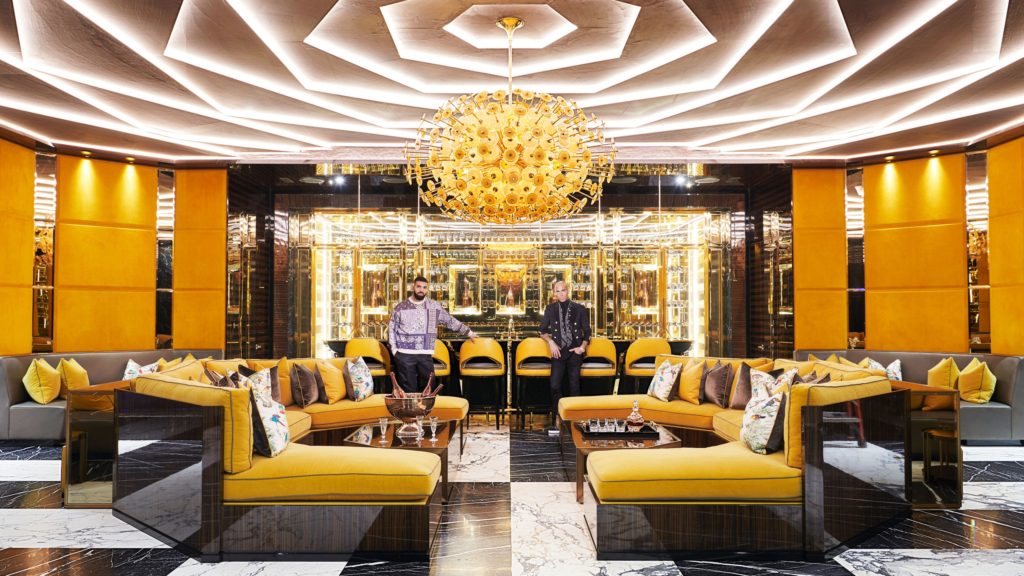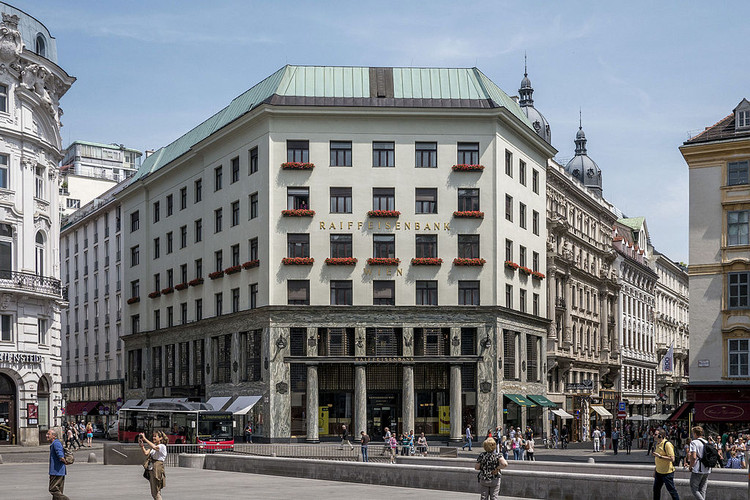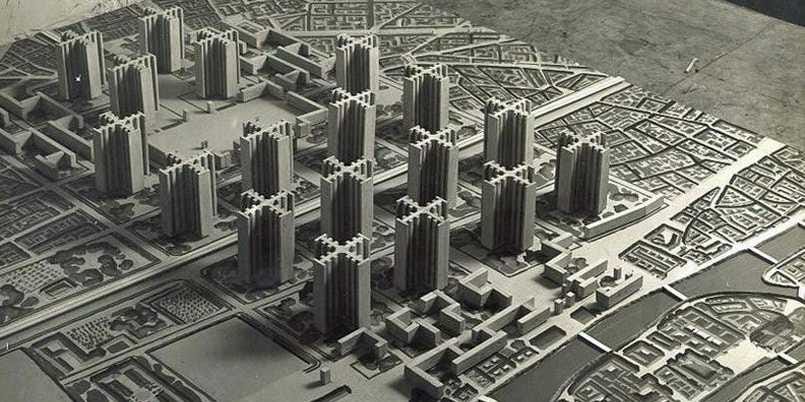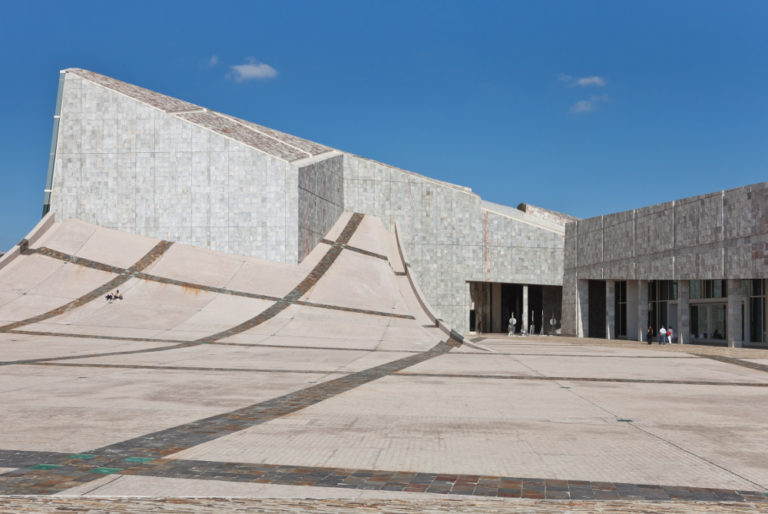The latest edition of “Architizer: The World’s Best Architecture” — a stunning, hardbound book celebrating the most inspiring contemporary architecture from around the globe — is now shipping! Secure your copy today.
Last year, The New Yorker published an interesting piece by Kyle Chayka titled ‘The North American Maximalism of Gigi Hadid’s and Drake’s Home Design.’ In it, Chayka states approvingly that, in 2020, “a new North American maximalism” is getting “revenge” on minimalism, which has been trying to “vanquish” purely ornamental detailing for over 100 years.
As evidence, he points to two celebrity homes that have recently been covered in the architecture press: model Gigi Hadid’s eclectic Manhattan apartment and Drake’s extravagant Art Deco mansion in Toronto. Both of these projects were overseen by architects and designers (Gordon Kahn in Hadid’s case, Ferris Rafauli in Drake’s) but with significant input from the famous homeowners, who hoped to create “dream homes” that reflected their personal taste.

Gigi Hadid’s apartment, designed with architect Gordon Kahn, mixes colors, patterns and textures in a way that screamed “maximalism” to the New Yorker. Image via Hello Magazine.

Drake’s Art Deco-inspired Toronto mansion, designed with Ferris Rafauli, represents a monumental form of maximalism. Photo by Jason Schmidt via Architectural Digest.
What stands out about this piece isn’t the observation that some celebrities are drawn to ornate decor — as Chayka points out, “maximalism… never really goes away” — but rather the author’s treatment of the subject of minimalism. By presenting Hadid’s and Drake’s homes as daring outliers, Chayka implies that minimalism is still the hegemonic aesthetic of our time.
More than 60 years after Mies van der Rohe said “less is more,” it seems that ornament still carries a hint of taboo. Include enough of it, and you are making a statement, even a provocation. As a reader, I wondered why this is. Does modernism, with all its utopianism and its prohibitions, still have a grip on contemporary design?
Ornament and Crime
Chayka’s article opens with a summary of one of minimalism’s canonical early texts, Adolf Loos’ 1908 lecture ‘Ornament and Crime.’ As a way to set the stage for a defense of maximalism, this was a canny choice, as the lecture is one of the least convincing architectural treatises ever written. It is also one of the most racist.

Walking The Walk: Adolf Loos built the minimalist Looshuis, in Vienna, in 1909. Hostile critics at the time called it “the house without eyebrows,” noting Loos’ pointed decision not to include detailing around the windows. It was said that the Emperor Franz Joseph avoided passing by Looshuis for the rest of his life. Photo by Thomas Ledl, via Wikipedia.
In ‘Ornament and Crime,’ Loos argues that ornamentation is uncivilized, reflecting a lack of moral restraint characteristic of children, criminals, and people from pre-industrial, non-Western societies. As evidence of the “degeneracy” of ornamentation, Loos points out that criminals often decorate their body with tattoos, a tendency they share with “the Papuan” who also “kills his enemies and eats them.” Like the Papuan, tattooed men are murderous. “If someone who is tattooed dies in freedom, he does so a few years before he would have committed murder,” Loos theorizes.
It follows that architects of the ornate Art Nouveau style (which Loos disliked) are similarly inclined toward violence — or at least more so than the modernist architect, who has evolved beyond the need for ornamentation and is able to find pleasure in the sheer rationality of his living space. Essentially, Loos posits a continuum between the amoral realm of nature and the moral fortitude of modern man, and he places himself and his preferred style of architecture at the advanced end of moral development.

Le Corbusier’s ‘Plan Voisin,’ a never-realized scheme to tear up central Paris and replace it with a series of minimalist concrete towers. Image via Business Insider.
Loos, I would say, is a less than ideal ambassador for minimalism. But the core ideas buried underneath his strange examples are pretty representative of how modernist architects thought about the subject. The titans of what was called the “modern movement” — Mies, Le Corbusier and Gropius — were less colorful writers than Loos, but they basically agreed with him that modern architecture would liberate mankind by stripping away the oppressive decorative trappings of past centuries.
Mies famously said that “architecture is the will of an epoch, translated into space,” echoing Loos’ idea that minimalism wasn’t just a stylistic preference, but embodied the very essence of modernity. And one glance at Plan Voison, Le Corbusier’s never-realized scheme to remake central Paris, illustrates that Corbu cared little for local details, and would have happily sacrificed the visual identity of Europe’s most iconic city on the altar of functionalism.
Populist Revolts
Most people find Plan Voison horrifying. And indeed, the zeal of 20th century modernists helped create a rift between architects and the public that still exists today, even as the profession has become far less evangelizing and doctrinaire than it was in modernism’s heyday. Populist denunciations of architecture are still written all the time by both left- and right-wing critics, who generally paint the profession with a broad and reductive brush.
In 2017, left-wing writers Nathan J. Robinson and Brianna Rennix wrote one of these polemics for Robinson’s popular socialist journal, Current Affairs. The piece is titled ‘Why You Hate Contemporary Architecture’ and the complaints are extremely familiar: once “beautiful” cities have been blighted with “ugly,” “cheerless” and “grim” modern buildings. The authors accuse architects of harboring a “paranoid revulsion to classical aesthetics” and condemn both the icy minimalism of modernism and the “irritating attempts” of postmodernists to “parody” the architecture of the past.

Peter Eisenman is no minimalist, but his deconstructive architecture has been criticized on similar grounds, as it is said to deny people simple aesthetic pleasures. His City of Culture of Galicia is among his most divisive buildings. Image via Current Affairs.
For Robinson and Rennix, all the “isms” of contemporary architecture are irrelevant. Each one of them shares the same problem: the architect’s stubborn insistence on denying the public what it wants, which are buildings that are comfortable, familiar and — yes — even nostalgic. They identify the deconstructive architect Peter Eisenman as a modern-day Loos, an ideologue and a moralizer who relishes the fact that his buildings lack popular appeal. This quote of Eisenman’s, taken from a 1982 debate with fellow architect Christopher Alexander, is presented as evidence for the charge: “If we make people so comfortable in these nice little structures, we might lull them into thinking everything’s all right, Jack, which it isn’t.”
Minimalism Today
The idea of the grim and fanatical architect standing between the common man and the sensible built environment he craves is extremely common — as a trope if not a reality. In Chayka’s piece, it factors in almost as a truism, and the invocation of Loos and his treatise gives it a sense of solidity. Good for Drake and Hadid, the piece argues, for standing up to the austere and self-denying dictates of minimalism!

This interior is minimalist, sure, but it is hardly cold and imposing. Minimalism today is often lyrical, and adapted for a more human scale. Image: Zhuyeqing Green Tea Flagship Store, X+Living Architectual Design Co. 2020 A+Award winner for Commercial-Retail Spaces.
Yet a glance through recent winners of the A+Awards reveals that architecture, today, is a diverse, global field, and it is no longer dominated by these factional debates between modernism, postmodernism, deconstructivism, and the rest. Architects all over the world are working to create buildings that meet the needs of local communities, often paying careful attention to issues like sustainability. And while they don’t always get it right, one thing you don’t usually see are self-righteous condemnations of things like “ornament” attached to the projects.
If the best contemporary architecture often features clean lines and an emphasis on raw materials, this is not usually due to an ideological commitment for function over form, but a reflection of a real aesthetic preference. (Cost concerns, too, play a role). Architects like Eisenman, who relish aesthetic difficulty, are in fact a rarity in the profession. (Nathan J. Robinson and Brianna Rennix don’t want you to know this, but there is beauty in clean lines too).

There is real beauty in clean lines and unadorned surfaces. When these elements are favored, it is not necessarily for arid ideological reasons. Image: La Point by L’Abri, 2020 A+Award winner for Concepts-Living Small.
When minimalism is proposed as an ethos, today, it usually has a much more personal character than that seen in Loos’ essay. For instance, the tidying guru Marie Kondo sees minimalism as a way to make your living space more personal and intimate. Her view of the good life is not one in which everything is fully optimized, but in which people are surrounded only by objects that “spark joy.” In this, her philosophy is exactly same as noted “maximalist” Gigi Hadid, who wrote on Instagram about “enjoying all the little corners” of her carefully curated space.
Zombie Modernism
There is one way, however, that minimalism continues to oppress people in the 21st century, but it is connected to mass production, not architectural theory. The most revealing part of Chayka’s article comes toward the end, when he complains of “the bland start-up minimalism of Article couches, Casper mattresses, and knockoff Eames chairs from Amazon.”
These products, Chayka explains, might seem modern or tasteful on first glance, but what they really represent is a “lowest-common-denominator style” that “has had its shortcomings exposed during these endless months of quarantine — there’s little pleasure in staring at a set of Floyd table legs strapped to plywood all day.”

The New Yorker’s Kyle Chayka says he has spent too much of lis life staring at tables that look like this. Image via Architectural Digest.
Years after its heyday, modernist design is popular once again, but in a zombielike form. Stripped of its utopian dimension, wherein it held the promise of a better and more orderly world, this type of decor is now just another readymade style. Chayka is right that there is no more individualism in this stuff than there is in the forced eclecticism advertised by an outlet like Pottery Barn. There is also nothing wrong with it, per se, but its omnipresence has made it feel monotonous and derivative.
However, if you find mass-market minimalism uninspiring, the solution isn’t necessarily “maximalism.” It is cultivating a space with pieces that have personal significance, which, again, is what many of today’s minimalists are already advising. The minimalist/maximalist divide Chayka lays out really belongs to another era.
The Loosian minimalist ethos lives on in the popular imagination far more vividly than it does within the architectural profession. To borrow an idea from Sigmund Freud, Loos’ contemporary in Vienna, minimalism has been widely internalized as a harsh dictum of the superego, which is why certain people feel compelled to argue forcefully against it. Even devoted maximalists and classicists, it seems, are tormented by a voice in the back of their head saying that form should follow function. This suggests that — for all its supposed unpopularity — modernism still has a hold on public taste after all.
The latest edition of “Architizer: The World’s Best Architecture” — a stunning, hardbound book celebrating the most inspiring contemporary architecture from around the globe — is now shipping! Secure your copy today.




